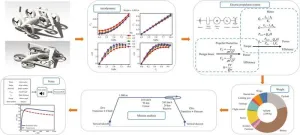(Press-News.org)
Giving very premature babies high concentrations of oxygen soon after birth may reduce the risk of death by 50 percent, compared to lower levels of oxygen says new research led by University of Sydney researchers.
When premature babies are born, they sometimes need help breathing because their lungs haven’t finished developing. To help babies during this process, doctors may give them extra oxygen through a breathing mask or breathing tube.
The study, published in JAMA Pediatrics, examined clinical trial data and outcomes of over one thousand premature babies who were given different oxygen concentrations. This included low concentrations of oxygen (~30 percent), intermediate (~50-65 percent) or high (~90 percent).
The study found for babies born prematurely, at less than 32 weeks (less than three quarters of the way through a full pregnancy), starting resuscitation with high concentrations of oxygen (90 percent or greater), could increase chances of survival compared to low levels (21 to 30 percent).
For comparison, the air we breathe, also known as ‘room air’ only has about 21 percent oxygen.
When a doctor provides oxygen to babies that need help breathing, there is a device that regulates how oxygen is mixed together to reach the desired concentration. The researchers believe higher initial levels of oxygen may jump-start independent breathing, but more research is required to explore the underlying cause for this effect.
The researchers emphasise that additional large studies will be important to confirm this finding, and that even when starting with high oxygen, it needs to be adjusted to lower levels quickly to avoid hyperoxia (oxygen poisoning).
How the oxygen is delivered during the first 10 minutes of the infant’s life is critical. Doctors may give the baby high levels of oxygen at the start but then monitor vital signs and continually adjust the oxygen to avoid over or under exposure.
If confirmed in future studies, the findings challenge current international recommendations that suggest giving preterm babies the same amount of oxygen as babies born at term, 21 percent to 30 percent oxygen (room air), rather than extra oxygen.
This study also demonstrates that there may not be a one-size-fits-all approach, and babies born prematurely may have different needs than babies born at term.
Worldwide, over 13 million babies are born prematurely each year, and close to 1 million die shortly after birth.
“Ensuring very premature infants get the right treatment from the beginning sets them up to lead healthy lives. There is no better time to intervene than immediately after birth,” said lead author Dr James Sotiropoulos from the University of Sydney’s NHMRC Clinical Trials Centre.
“The goal is to find the right balance – how do we give enough oxygen to prevent death and disability, but not damage vital organs.”
“Whilst promising and potentially practice-changing, these findings will need to be confirmed in future larger studies.”
Historically, oxygen with a 100 percent concentration was used to resuscitate all newborn infants. But due to studies that found high concentrations of oxygen over time can lead to hyperoxia and subsequent organ damage, in 2010 it prompted changes in international treatment recommendations for the use of blended oxygen (starting with low oxygen) for preterm infants.
However, researchers say the change was mainly based on evidence for full-term infants, who have fully developed lungs and who are often not as sick as premature infants.
To date, there is little conclusive evidence to guide best practice for premature infants.
The researchers emphasise the findings should not minimise the dangers of hyperoxia.
“The debate around exactly how much oxygen is best for extremely premature babies is still ongoing but, ultimately, everyone has the same shared goal of determining the best treatment for newborns,” said Dr Anna Lene Seidler from the NHMRC Clinical Trials Centre.
“Our findings, together with all the other research that is currently happening, may help the most vulnerable preterm infants have the best chance of survival.”
“We are very lucky to work with a highly collaborative international group on this question, some of whom have been studying it for decades. The group’s diverse expertise and experience is a major strength of this work,” said Dr Sotiropoulos.
-ENDS-
Research paper link (live when embargo lifts): https://doi.org/10.1001/jamapediatrics.2024.1848
END
For those suffering from treatment-resistant depression, the anaesthetic drug ketamine offers hope, but it has side effects and can be costly to access – a University of Otago-led clinical trial may change that.
Working in collaboration with New Zealand’s Douglas Pharmaceuticals, researchers have conducted a trial of ketamine in an extended-release tablet form.
The study, published in prestigious international journal Nature Medicine, involved 168 adults for whom regular anti-depressant therapy ...
An unexpectedly versatile and regenerative stem cell in early embryos may be key to creating new effective fertility treatments, suggests a new study in mice from the University of Copenhagen.
It probably will not surprise anyone that pregnancy is a very complicated process. First, a sperm cell must find its way and fertilize an egg in the fallopian tube, after which the egg begins to divide. After about five days, the egg becomes a blastocyst, which eventually develops into a fetus.
But for more and more people, fertility is becoming increasingly harder to achieve due to various factors ...
A new tablet form of ketamine has shown promise in treating severe depression, offering a potential alternative to existing clinic-based treatments that can be expensive and lacking in convenience for some patients.
Unlike the injectable and nasal spray alternatives that require clinicians to monitor patients for two hours while side effects subside, the slow-release tablet form can be taken safely at home without medical supervision and with negligible side effects.
Led by Professor Paul Glue of University of Otago, researchers from UNSW Sydney and the affiliated Black Dog Institute (BDI) collaborated with colleagues from ...
In recent years, a new era of transportation innovation has unfolded with the introduction of autonomous electric vertical take-off and landing (eVTOL) aircrafts. These advanced air mobility (AAM) systems are poised to revolutionize urban and regional transportation by offering efficient, sustainable, and rapid transit solutions, potentially transforming daily commutes and cargo deliveries alike.
eVTOL technology, which enables aircrafts to ascend, hover, and land vertically, has become a focus for both academic research and commercial ventures due to its numerous advantages ...
Singapore, 24 June 2024 – A study led by clinician-scientists and scientists from the National Cancer Centre Singapore (NCCS) and A*STAR’s Genome Institute of Singapore (GIS) and funded by the National Research Foundation Singapore (NRF) has discovered unexpected molecular heterogeneity even within the same liver tumours. More than 40% of HCC harbours more than one molecular subtype within the same tumour and in these, the clinical outcomes for the patients are best predicted by the most aggressive subtype. This phenomenon, termed the “bad apple effect”, has significant implications on the understanding of liver cancer and suggests that a more holistic sampling ...
New Haven, Conn. — Rising health care prices in the U.S. are leading employers outside the health care sector to reduce their payroll and decrease their number of employees, according to a new study co-authored by Yale economist Zack Cooper.
The study, published June 24 as a working paper by the National Bureau of Economic Research (NBER), found that when health care prices increased, non-health care employers responded by reducing their payroll and cutting the jobs of middle-class workers. For the average county, a 1% increase in health ...
Press materials are now available for NUTRITION 2024, the annual flagship meeting of the American Society for Nutrition (ASN). Top nutrition scientists and practitioners from around the world will gather to share the latest research findings on food and nutrition during the meeting, held in Chicago from June 29–July 2.
Register for a press pass to attend NUTRITION 2024 in person or to access embargoed press materials before the meeting. Explore the meeting schedule, poster presentations, poster theater flash sessions and oral presentations to see all the exciting research ...
Ann Arbor, June 24, 2024 – Alcohol consumption is involved in a large proportion of homicides and suicides each year in the United States, but there has been limited evidence on how policies targeting alcohol use influence violence. A statistical analysis in the American Journal of Preventive Medicine, published by Elsevier, indicates that more restrictive alcohol policy environments are associated with a reduction in specific states’ homicide rates.
Lead investigator James P. Murphy, PhD, RAND Corporation, Santa Monica, CA, says, "Previous studies have found a significant relationship between some state-level ...
The stereotype of mathematics and mathematicians involves a solitary pursuit of knowledge, but Eric Stachura knows better.
The Kennesaw State University assistant professor of mathematics works on quantitative analysis of electromagnetic waves and keeps a collaborative research practice with colleagues near and far. That partnership has led to a three-year grant worth $223,206 from the Army Research Office, a director of the U.S. Army Combat Capabilities Development Command Army Research Laboratory.
“It is a very collaborative subject, ...
The National Institutes of Health (NIH) has partnered with the U.S. National Science Foundation (NSF) to provide approximately $15.4 million over three years for research into the structures, functions and interactions of ribonucleic acid (RNA), as well as the creation of RNA-based technologies. RNA sequencing and the mapping of RNA modifications have gained significant momentum in the genomics community in recent years, with a new report from the National Academies of Sciences, Engineering, and Medicine outlining a roadmap for the field to build technology and infrastructure to allow researchers to more completely study and catalog RNA and its modifications.
“A ...


